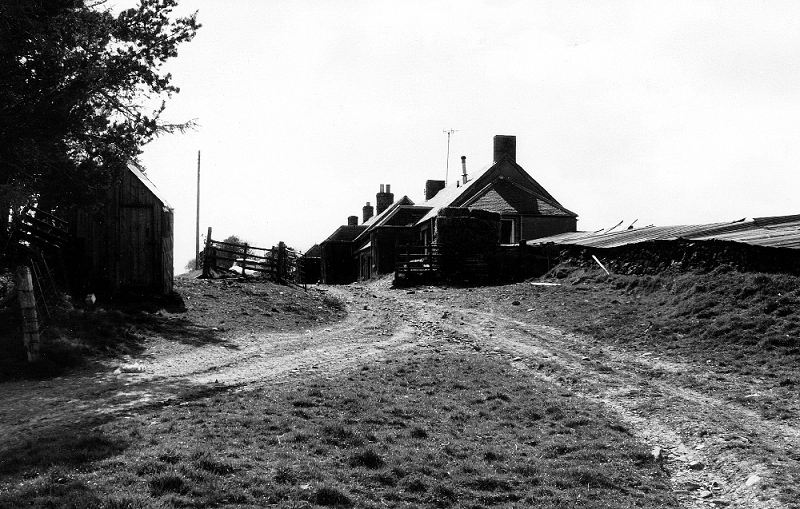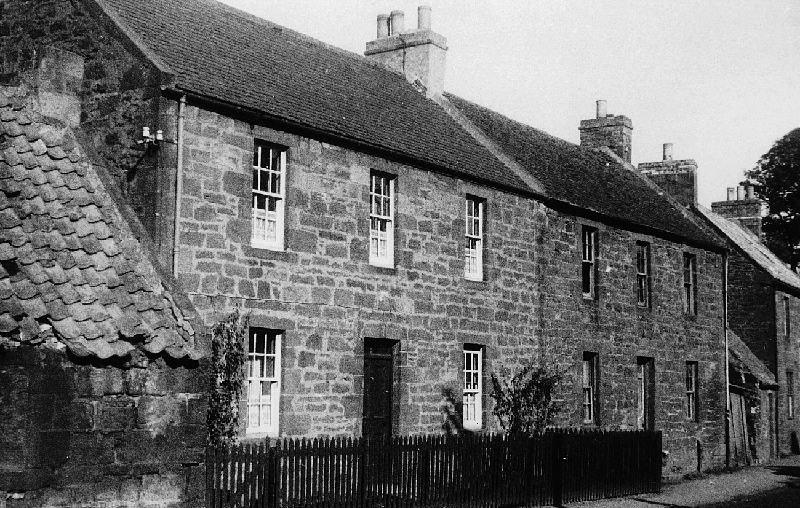Outwith the village, many people lived in cottages on the farms; the chart below indicates the number of these over the period. The biggest change was that, by 2000, most farm cottage residents would no longer have any association with the land.
| Farm | 1948 | 1961 | 1990 | |||
|---|---|---|---|---|---|---|
| Occupied | Empty | Occupied | Empty | Occupied | Empty | |
| Baro in Linplum | 12 | – | 6 | 1 | 10 | – |
| Chesters | 4 | – | 4 | – | 3 | – |
| Garvald Mains | 4 | 3 | 6 | 1 | 6 | 2 |
| Newlands | 5 | 1 | 4 | 1 | 6 | – |
| Quarryford | 6 | 2 | ? | ? | 11 (3 new) | – |
| Castle Mains | 6 | 4 | 7 | – | 7 | – |
| Hopes | 3 | – | 3 | – | 3 | – |
| Garvald Grange | 3 | 2 | 4 | 3 huts | 4 | 3 |
| Tanderlane | 7 | 1 | 9 | – | 5 | 1 |
| Snawdon | 7 | 1 | 9 | 1 | 8 | – |
| Carfrae with Danskin | 7 | 1 | 8 | – | 9 | – |
(excludes the monks’ estate of Nunraw, Nunraw Barns and Castle Moffat)
Living in a farm cottage in the 1950s
‘In the 1950s, our family of two adults, two children, a young herd (who generally stayed for about three years, and always lodged with the farm manager) and, for a month a year, a lambing man, lived at the Hopes in a small house with two bedrooms, a kitchen/living room and a scullery. My parents slept on a fold-down couch, the herd took one bedroom, and my sister and I shared the other bedroom.
In 1955, the house was extended, and an extra bedroom was added. Further extensions incorporated the byre as a further bedroom, and the kitchen was extended, and a bathroom added, utilising part of the steading that was originally the coachhouse. It was further renovated in 1985.
The floors were covered with lino; electricity came up the glen in 1954, and we acquired our first TV in 1960’.
Ray Wilson, whose father was the manager on the Hopes estate

Snawdon
On the farms, many of the cottages were improved. At a glance they were the same as when occupied by farm workers, but they had been carefully modernised, often using ‘traditional’ materials; they were usually occupied by ‘incomers’. The latest increase of residences in the parish took place between 1995 and 2000 at the old steadings at Garvald Grange. Initially buildings on the north side of the quadrangle were updated and then a further project with a new frontage facing the road was built. The eight or nine homes created were occupied by commuters or used as holiday homes.

Garvald village with ‘Woodburn’ (far right) and ‘Treetops’ (left)
By 2000, in Garvald village there were 65 houses, 18 of which had been built during the 1945-2000 period; many had been modernised, but had not changed in character. The three groups of pre-1945 council houses, 14 in all, were two-three-bedroomed bungalows, and some were privately owned. A number of tumbledown cottages, which were part of the Nunraw estate, and others which were privately owned, had changed hands and were modernised. In all of these the original character was maintained – the red sandstone, the small windows, the pantiles or slate roofs. Those that had been shops were adapted as cottages, and the two ex-manses had become private homes.
A group of six houses – Burnside Court – were built in 1974, on the land behind the pub where the old wartime huts had been. After the school closed (31 March 1971) the buildings were ‘adapted’ to create two homes, and by the 1980s, two new houses were built on the old school land. In 1991, three two-storey houses at the west end of the main street were built on Tanderlane land. In 1991, seven council cottages were built on a small rough field, behind existing cottages at the foot of Kirk Brae, at the east end of the village – two three-bedroomed, three two-bedroomed, and two one-bedroomed. None of these new developments made a noticeable difference to the appearance of the village.
Utilities
In the 1960s, there were still at least three operational standpipes in the village street at which buckets could be filled, although some attached a hosepipe to the tap and filled a drum at the cottage!
In the 1950s and 1960s the village supply came from the Donolly reservoir and I was told not to be surprised if fish came out of the tap.
The best drinking water came from a spring in the far corner of the haugh. In the 1970s when the Whiteadder reservoir came into operation, the village was connected to this mains supply. In 1999 the last cottage had water laid on. Meantime, Thorters above Castle Moffat had supplied the Nunraw estate. The earliest pipe-borne water in the parish went from the Hopes reservoir, to supply the town of North Berwick. It was only when some trees fell and ruptured the main in early 2001 that it was realised that most of the farms in the western part of the parish were on this line.
At the beginning of the period some of the old cottages had no bathrooms and only an earth closet in the garden. At the bottom end of the village the pends between the cottages on the side next to the Papana were used by those on the other side of the street to carry their slops and empty them in the burn! By 2000 the septic tank system below Africa (the most easterly cottage in the village) had reached capacity. The water board was in the process of acquiring land and access through the glebe field above the church in order to build a bigger plant.
The farms have individual septic tanks.
Shops & Services
The village has always had sources of food. In the earlier years there were two shops. Mrs Bolton had basic groceries as well as sweets and soft drinks for passing visitors; the shop was located opposite the police house, and was there to the 1970s. Mrs Catleugh ran the post office as well as a small general store. This was at the Gifford end of the village, at the last Orlit house and just before the school. It later moved down the street, and Mary Dods ran it. By 2000, the post office only opened two mornings a week, and was run from one of the council houses.
There were also mobile shops that visited the village, the Co-op van with groceries and ‘Wee Tait’, the butcher with fresh meat. Later a greengrocer came every Thursday evening, sometimes as late at 10pm. In the 1990s, two fish vans, one from Eyemouth on a Tuesday and the other from Cockenzie on a Saturday came with really fresh fish. Throughout the period milk was delivered on the doorsteps, latterly in the early hours of the morning three days a week. At the very end of the period several people had computers and could order food to be delivered via the Internet.
For a number of years in the middle of the period a voluntary rota was organised and different residents would fetch the daily newspapers from Haddington and put them in a box by the village green. In the 1990s, Knox, the newsagent in Dunbar, took over and delivered the papers from door to door.
The mobile van of the public library visited the village regularly.
The Garvald Inn closed in 2000 (see Tourism).